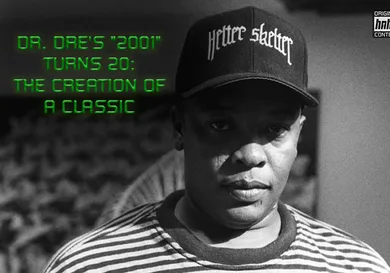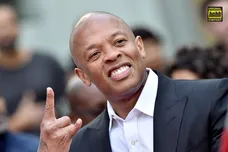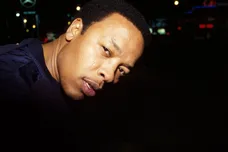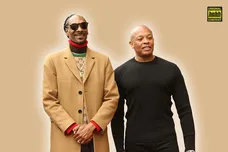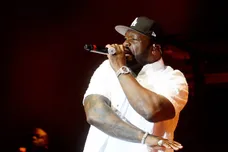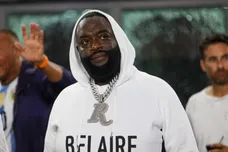Reinvention is among the artist's most difficult challenges. Especially in the aftermath of hard-fought success. As Dr. Dre approached the late-nineties, the Los Angeles producer was no stranger to greatness. His work alongside Ice Cube, Eazy-E, MC Ren, and DJ Yella helped usher Gangster Rap into the mainstream, solidifying it as a dominant commercial genre. His time under Suge Knight’s Death Row umbrella, creating alongside Snoop Dogg, Kurupt, Daz Dillinger, and Nate Dogg, led to one of the great albums of our time: The Chronic. Dre’s creative touch had reached Midas levels, to the point where Michael Jackson and Madonna were reaching out for his production.
The first phase of Dre’s musical run began in 1986 with the formation of NWA, culminating with his 1996 departure from Death Row. A full decade, in which he worked on two group albums (Straight Outta Compton & N***az4Life), a solo album (The Chronic), and Snoop’s Doggystyle. Not to mention his contributions to the soundtracks for Above The Rim and Murder Was The Case, classic singles like “Keep They Heads Ringing” and “Natural Born Killaz.” A discography that would match the pace of today’s most prolific artists, one he pioneered as the mind behind the boards. Not only writing and performing, but honing his touch as an audio engineer. An additional talent that would go on to form one of his arsenal’s most valuable weapons.
Brian "Big Bass" Gardener and Dr. Dre in the studio - image courtesy of Gardener, for HNHH
“I’ve been working with Dr. Dre from the beginning,” explains 2001 mastering engineer Brian “Big Bass” Gardener. “Even before NWA, with [World Class] Wrecking Crew. We all know what happened when NWA hit. That was quite an experience. Having the whole crew in their younger mode, hearing that totally different sound. And of course, Dr. Dre was the one sitting right next to me ready to dig in.” A scholar who would go on to lead by example, Dre’s eagerness to study Gardner’s craft revealed the depths of his vision. A vision that would lead to the creation of clockwork hits, a talent not lost on Gardener. “I’ll never forget back when Dre and I were mastering “California Love” and I immediately knew this was a killer hit,” he reflects. “I stopped the 1/2 inch machine on the very first playback and asked him ‘how do you do it?’ He just smiled and said ‘what?’”
THE WATCHER
There have always been darker undertones to Dre’s music. Death Row’s brand of gangster rap seemed to favor the late-night stick up, with instrumentals like Snoop’s “Pump Pump” and Dre’s own “Natural Born Killaz” striking menacing chords. A revisitation of The Chronic reveals a gritty reality, one reflective of the early nineties' cultural landscape. At the turn of the millennium, hip-hop was undergoing a stylistic shift. Best-selling artists like Jay-Z had expanded their sonic palette, forsaking his New York mafioso aesthetic in favor of futuristic tones from Timbaland and Swizz Beatz. DMX exploded onto the scene with back to back number one albums. Snoop Dogg had left Death Row in his wake, having linked up with Master P’s No Limit records. Though difficult to believe, Dr. Dre’s position in the game was in an alarming state of flux.
Snoop Dogg and Dr. Dre, circa 1990 - Raymond Boyd/Michael Ochs Archives/Getty Images
His work with The Firm, the closest he’d come to lacing East Coast mafioso rap, flew under the radar. His introductory Aftermath Presents compilation album was met with a lackluster response. With his reputation at Interscope dwindling with every move, the signing of a young Eminem proved to be among the game’s clutch Hail Mary plays. Creatively reinvigorated, Dre found himself hitting the lab with fervent purpose. With him came a pair of musicians in Mike Elizondo and budding pianist Scott Storch, two men that would play an integral role in shaping the modern Dre sound. As Storch tells it, we have Ruff Ryders legend Eve to thank for that. “My first time in LA, I ran into my old friend Eve,” he explains. “At that time, she was signed to Aftermath.” After Eve made the introduction, Storch’s audition process began.
“She brought me in to meet Dre,” he continues. “I didn’t have anything but my fingers with me. No cassettes, no DAT tapes, no CDs of any music. Dre was like ‘just play piano.’” And so he did. “I never really left. I kept working. The next day we made ‘Big Egos.’” Speaking about the creation process, Storch likened it to that of a band rehearsing, which speaks to the album’s organic instrumentation. “Mike Elizondo on the bass, Dre’s on the MP kicking it live, I’m on the keys,” remembers Storch, a wistful tone in his voice. “It was just music and gelling. Dude, I couldn’t even tell you how much magic is still on tapes that are sitting in Dre’s vaults, that destroys the music of today. Crazy shit. We jammed, man. We were jamming.”
With Storch’s arrival came a stylistic shift; while his penchant for eerie-piano progressions would eventually come to define Dre’s new-millennium sound, the vibe was cultivated and birthed on 2001. “I came in and had this weird ominous piano-driven sound. It was something I crafted living in the East Coast, and I brought it to the West Coast. Dr. Dre harnessed it,” explains Storch, putting his role into perspective. “He understood what to do with that and turned it into a new generation of West Coast music. It went from being Funkadelic, but still cool and dark, to a new orchestral type of thing.”
Dr. Dre, 1995 - Steve Eichner/WireImage/Getty Images
Long Beach rapper Knoc-Turn’al experienced a similar audition process. Having served four years in the penitentiary, Knoc had amassed no shortage of bars. Upon connecting with producer Mark Sparks (The Roots), a meeting with Dre was arranged. “I was sitting with my wife, telling her I don’t know what to rap,” says Knoc, reflecting on that day. “It was crazy cause Dr. Dre had walked by when we were upstairs. I thought he was going to the bathroom or something, but he was on the other side of the wall listening to me rap. He finally called me downstairs and put on a beat. I started freestyling. He changed the beat, I changed my rap style. He changed the beat again, I changed my rap style. He was like ‘damn, how many people in there? Let’s find out.’”
“I used to be the first muthafucka on the block on the scene and the last muthafucka to leave,” Knoc continues. “Steel sharpens steel. We were a whole bunch of great-ass artists that Dr. Dre found and put together. He wanted us to work with each other. It was never a problem in the studio. No egos. Let’s get this shit done - it was epic.” Outlining the core creators as himself, Hittman, Eminem, Ms. Roq, and Mel Man, Knoc revealed that Dre essentially gave them space to let their creativity flow. “Dre let us have freedom to do what we wanted to do. He’d go in there and make the beats. He’d make sure we had whatever we needed, whether it was liquor, weed, whatever. He’d let us create, and he’d pick and choose.”
Though much was being made about the buzzing Slim Shady, the 2001 sessions brought a new protege, Bronson Avenue lyricist Hittman. “Before 2001 started, I did not know Dr. Dre personally,” explains Hitt, reflecting on his journey working with Dre. “Like most fans, I only knew him through his impressive body of work. I was brought into the fold because at the time Dre was looking to create or develop a rapper named ‘Lil Homie’ to be an Eazy-E type sidekick for the project.” Citing Mel-Man, Ali S, and Taz Arnold, as the main reasons he ended up on Dre’s radar, Hitt opened up about the pressures inherent in following up a hip-hop classic. “I would say I was more anxious than I was intimidated,” he reflects. “Important to note, the working titles of the project in the early stages teetered between The Chronic II and The Chronic 2000. So attempting to maintain the integrity of The Chronic while expanding on it definitely contributed to many sleepless nights.”
Coming off the release of 40 Dayz & 40 Nightz, a young Xzibit was in the midst of breaking out as a rising West Coast star. It would ultimately be the guiding hand of Snoop Dogg that would bring X into Dre’s world. “Snoop called me, said he wanted me to do this song,” explains X, referring to the classic “Bitch Please.” “Dre was doing the beat. It was over at Encore Studios, so I went over there. Dre was in there. He was like ‘Check this beat out’ and pushed play. I sat there for fifteen minutes, I wrote my verse and then I laid my verse then I left. I thanked him for the opportunity,” Xzibit laughs. “Dre was like ‘wow, you not gon’ hit me up for no money or nothing?’ Because I already had a record label, I was thankful to even be considered for the record. Dre told me that really stuck with him. A lot of people come at him with a bunch of bullshit. I didn’t do that. Then it was kinda like, 'hey, you want to come check out this record? I’m working on a record.'”
Eminem, Xzibit and Dr. Dre attend MTV's Spring Break, 2000 - Frank Micelotta/ImageDirect/Getty Images
As Hittman tells it, the stakes were undoubtedly high: “The future of Aftermath was riding on this album so it had to be the way Dre envisioned it.” But as Xzibit explains, it’s unlikely Dre was fazed in the slightest. “He’s very nonchalant when he talks about big shit,” reflects X. “That’s one thing you’re going to learn about Dre. It may seem like fuckin’ space travel for us. For him it’s just another hour of the day.” Contributing vocals to three of the album’s tracks, Xzibit likens the studio sessions to a creative goldmine. “Sometimes there would be a beat, and sometimes there would be a vocal, and he’d move it around,” recalls X. “The groundwork was laid, and they kept adding songs and adding stuff to the songs that already existed.”
“Dre had a vision. He’s an album maker,” says Scott Storch, the admiration evident in his voice. “When he did 2001, he gave us one of the craziest albums in history. Skits, everything built-in. A journey. You want to listen to this whole album, not just a track. He knows how to do that.” On that note, even the skits proved innovative; the introductory cut “Lolo” certainly left a lasting impression on Xzibit. “He actually brought a Lowrider to the parking lot of Encore,” marvels X. “Miked it up from front to back, so you could hear the hydraulics. How the car crashed. They hopped the car in the parking lot and recorded it. With chords all the way back to the studio. It was the craziest shit I ever saw!”
“Hearing those beats in them finely tuned rooms that Dre chooses to dwell in was sensory overload,” continues Hittman, who can proudly say he contributed to ten of 2001’s songs. “It felt as if your heart was gonna jump out your chest, the wax in your ears starts poppin’, everybody bobbing their heads uncontrollably. A surreal experience indeed.” Naturally, such a wealth of music would serve as the perfect environment for healthy competition, especially given Dre’s particularly lofty standards. “When Dre threw on a beat the vibe would fluctuate from communal enjoyment to competitive skepticism,” remembers Hitt. “You start to see all the writers reaching for pads and pens trying to be the one to come with the illest shit. And whoever came with it is who ended up on the track.”
“The moment I felt that I had proven myself is when the album was finally turned in to Interscope and I had remained on so many songs,” laughs Hittman. “Anyone who has ever worked with Dre knows your placement on a song is not definite until it’s in the mastering phase.” Knoc-Turn'al found himself experiencing a similar process, one that left him feeling wholly validated. “We made over five-hundred songs for that album,” says Knoc. “Dre used to be like ‘Knoc-Knoc, what’s up!?’ That’s what he calls me. Everyone who knows him real well calls him Captain, or Cap. When he came and handed me 2001 before it came out, I saw my name on four songs. I was like, woah. I have arrived.”
Echoing Hittman’s comments, Xzibit confirms that a song’s final lineup remained a mystery until the final release date. “The first record I did for that record was ‘What’s The Difference,’” says X. “Hittman was on the record first. Dre let me take a crack at the verse and it stuck. Hittman was all over the album, so Dre was like ‘You can get on this song.’” Despite the occasional act of generosity, Hittman ensures that Dre stood firmly behind his vision. “Perfection is always the goal when working with Dr. Dre,” explains Hittman. “I witnessed it throughout the recording process of 2001, whether it was Dre getting the best performances out of the artist, himself included, instructing the musicians on the feel or pocket he wanted them to play in, and most critically in the mixing and sequencing portion of the project.” It’s no wonder Dre christened himself as The Watcher. Leading by example, applying his brilliance to every strand of the album’s DNA. Basically, as Hittman puts it: “You gotta come correct or don't come at all.”
“Don’t get me wrong, there’s some verses I did where Dre was like 'Oh hell nah!'” laughs Knoc. “But it was about work ethic. Not giving up. It’s not about being the best rapper, it was about being humble and serious about your career. The more you show up, the better you got. You can’t hang around all these great people and not get better.” And show up he did, relocating to be in closer proximity to the laboratory. “I moved to Sherman Oaks, where Dre had a studio down the street,” he continues. “I didn’t know what was going to be what. I didn’t know if I was going to be on the album. I was doing whatever I could to actually get on the album, cause I knew it was a great opportunity. I’ve always respected Dr. Dre as a producer. There was a point where I was trying to go every day that I could. Even if he wasn’t there, they would let me in and I would try to create something.”
DOPE CALI PLATINUM CLASSICALS
Though much has been made about the legendary singles, from “Still D.R.E.” to “Forgot About Dre,” “What’s The Difference” to “The Next Episode,” a true classic must be stacked from top to bottom. 2001 doesn’t fail in that regard, with Hittman’s favorite song being one of his duets with the Doctor. “‘Light Speed!’ One of my favorite songs on 2001 to this very day,” he says, looking back on the track’s lengthy creation process. “It’s a trip how that one came about. I remember Dre giving me a beat tape consisting of four instrumentals. What you all know now as ‘Bang Bang,’ ‘Fuck You,’ ‘Light Speed,’ and a song called 'The Game' that I wish would’ve made the final cut.” By his own admission, however, “Light Speed” was initially underwhelming to his ears.
“Out of the four, I liked 'Light Speed' the least. At the time it was just the drums and the bassline. I don't even think it had that plucking guitar sound in it yet. I zoned out to the beat tape for about a week. During our vibe and brainstorm sessions, Dre would ask me if I had for something for that beat in particular, and I’d be like uh, not yet.”
Hittman and Mel Man, year unknown - image courtesy of Hittman, photographed by Adam Bravin
From the sound of it, creative differences were brewing. Hittman and Mel Man on one side, Dre standing fixed on the other. “Dre didn’t agree and was determined to prove us both wrong,” continues Hitt. “He persisted with his inquiry until one night in the studio I spit a verse retrieved from my rhyme infested mind. He suggested that I go in the booth and lay it but this time 'say it kind of behind the beat’ which seemed weird to me but I did it anyway.” After lacing a reference track for Dre, Hittman watched as “Light Speed” began to manifest before his eyes.
“He, Mel and the musicians were starting to build on the track and it was sounding amazing!” remembers Hitt. “I could not believe how dope the beat was turning out to be. Meanwhile, me, Knoc and Ms. Roq was vibing out and trying to come up with a hook for the song. I think Six-2 was in the house that night as well.” Hitt explains the idea came from Dre’s decision to use THX in the album intro, the brainchild of Star Wars creator George Lucas. “I suggested we call the song 'Light Speed,'" he reveals. “Once we agreed on the title, the hook just seemed to flow. Next thing we knew we’re in the booth laying and layering the hook for 'Light Speed.' Around 2:35 in the AM, we’re pleased with our work for the day and preparing to leave,” he continues. “All of a sudden we hear the clanking of ice and liquid against a plastic cup through the studio monitors, which means Dre must be in the booth and ready to record. Mel looks at me and says ‘Welp, sounds like another all-nighter.’ I gave him a look that said ‘DAMN,’ and we fell out laughing.”
FROM DETROIT TO COMPTON
Before being cordially invited to contribute to the 2001 sessions, a young Royce Da 5’9” was trying to make moves in New York City, negotiating to sign his first record deal. The year was 1999, and his fellow Detroit emcee slash Bad Meets Evil group-mate Eminem had recently linked up with Dre’s Aftermath Records. Five years Em’ junior, Royce found himself taking advice from the rising Slim, who got wind of Royce’s budding deal with Herbie Love Bug. “I was about to do that deal and Em was like 'Herbie Love Bug? Over my dead fuckin body,'” reflects Royce. “He told me to send some music out there, so I Fed-Exed some of the stuff I was working on. I’m just chilling at my mom’s crib, and my dad comes in like ‘you got a call. Somebody named Dr. Dre is on the phone.’ I was like What!?”
Royce Da 5'9" with Eminem at a New York City venue, 1999 - Catherine McGann/Getty Images
“I was like holy shit,” remembers Royce. “My heart dropped. I knew it was him, I caught his voice immediately. He was like 'I like your shit man, Marshall played me your shit, man. I wanted to see if you wanted to come out here and rock with us. We working on some stuff.'” Before long Royce was in Los Angeles, reuniting with Em in Dr. Dre’s studio. “He was playing all kind of fire beats,” continues Royce. “I was just writing stuff. As much as I could. I was just excited to be in the environment. I thought he was a genius, that everything he did was classic. I walked in a Stan.” Still in his early twenties, his debut album Rock City yet to manifest, the 2001 sessions proved a creative goldmine for the lyricist. “Dre was open to trying anything to see how it works,” says Royce. “He never said nothing that fucked with my confidence. I remember being out there for a couple days, by the time it was day two, I wasn’t even nervous about writing no more.”
Though he wasn’t actually in attendance when Em laid down “Forgot About Dre,” Slim was eager to show the track to his Bad Meets Evil groupmate. “He played me 'Forgot About Dre' and 'Kim,'” reflects Royce, singing the latter’s haunting chorus. As he tells it, their excitement playing back the tracks was pure, childlike. “I was like, wow. Em’s always excited about the process. Back then, he didn’t think at all. Now, he’s way more calculated with the way he does what he does. Back then, he was reckless. The studio vibe was so carefree, we didn’t know what we were witnessing. We didn’t realize we were a part of history in those moments.”
Eminem and Dr. Dre, 2000 - Brian Rasic/Getty Images
For Royce, his experience at the 2001 sessions proved to be a masterclass in the process, as taught by the game’s most revered professor. Yet some of his reference tracks, most notably “The Way I Be Pimpin” and “The Throne Is Mine” weren’t entirely fitting within Dre’s overall vision. It was ultimately a shared moment of emotional honesty that cemented Royce’s presence on the album. “I feel like the universe has always spoken to me,” says Royce. “I was penning a bunch of shit, but I was still a baby. I wasn’t as seasoned with the song structures and the writing as Marshall. Marshall wrote 'Forgot About Dre.' He’ll go in there and write a straight-up hit like it was nothing. I was writing all kinds of shit, but nothing was really sticking.”
“When I got 'The Message' beat, right before I was supposed to go out there, a friend of mine got killed,” remembers Royce. “The beat spoke to me. I thought to write about my man from my perspective. I'ma just lay it and see what Dre say. When I’m laying it, Dre is just staring at me through the glass of the booth. I’m like, he must not like this one. When I’m done doing the verses, he went quiet for a minute. That’s when he told me about his brother.” In 1989, Dre’s half-brother Tyree Du Sean Crayon was killed during a street fight; he was 21 years old. “The Message” serves as his eulogy, a beautiful moment of reflection borne from shared trauma. It’s no wonder Dre opted to close out his masterpiece with the most emotional song of his career. “Literally, everything I said to a T, Dre didn’t change anything,” says Royce. "'I'm still paging you, 911, straight in denial.' Dre did the same thing. Same thing I was rapping about. It was telling as fuck.”
THE AFTERMATH
Nobody’s done it like Dre. Going from NWA, to Snoop, Marshall, 50, and Kendrick. He’s basically Quincy Jonesed the entire lineage of hip-hop. The entire time it’s been in existence he’s been making classic contributions. It’s no surprise he’s one of the guys at that billionaire status.”
- Royce
Twenty years later, 2001 remains one of the defining albums of our time. Those who helped craft it still value the experience as a creative highlight, where different voices connected in bringing Dre’s vision to life. And from the sound of it, they knew they were part of something timeless. “When I heard 'Still D.R.E.' for the first time, we all knew that we had it,” remembers Xzibit. “The album was dope as it was, but when he played the single for everybody. It was like, wow. We’re about to change the world with this.”
Dr. Dre portrait, 1999 - David Tonge/Getty Images
“I went into Dre’s studio a baby and came out a grown-ass man,” says Storch, who played a pivotal role in bringing “Still D.R.E” to life. “Dre is the Quincy Jones of hip-hop. He knows what he’s doing from the programming to tweaking mixes and EQing his snares and kicks in such a way. Fucking genius, man. Dude has got incredible ears and instincts.”
“We all worked together,” says Knoc. “Dre put together a brand new team of artists he believed in. The mission was to get that Chronic album done so we could be solidified and go platinum and have our own career. That’s what Dr. Dre does. That’s what he’s always done.” “2001 changed everything about my life,” says Hittman. “Before it came to be, I lived in the hood. Now I live in the 'burbs' for instance. I can turn on any classic hip-hop station and eventually hear something I’ve worked on or someone I’ve worked with. I am appreciative and humbled to have been a contributor to such a well-received offering. Chronic class of 2001, we did the damn thang!”
But beyond all the memories made, the classic songs created, perhaps there remains an unsung hero tying it all together. “Of course he ran the album by people, but ultimately, if I can be absolutely real, Dre always listens to his wife,” laughs Knoc-Turn’al. “He lets her listen.”
